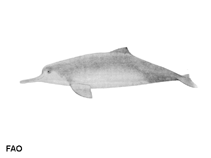Lipotes vexillifer Miller, 1918
Baiji
Classification / Names Common names | Synonyms | CoL | ITIS | WoRMS
Mammalia | Cetartiodactyla | Iniidae
Environment: milieu / climate zone / depth range / distribution range Ecology
Pelagic; potamodromous (Ref. 75906); freshwater. Subtropical; 31°N - 28°N, 112°E - 122°E
Distribution Countries | FAO areas | Ecosystems | Occurrences | Introductions
Asia - Inland Waters: China and Yangtze River.
Length at first maturity / Size / Weight / Age
Maturity: Lm 200.0 range ? - ? cm Max length : 230 cm TL male/unsexed; (Ref. 1394); 260 cm TL (female); max. published weight: 135.0 kg (Ref. 1394); max. published weight: 135.0 kg
Found in the middle and lower reaches of the river. Feeds on a large variety of fish species (Ref. 1394). Major threats to baiji dolphins includes fisheries, degradation of habitats, river traffic, water pollution (Ref. 85335, 85336), and rolling hooks known to snag and drown baiji (Ref. 85336). In 1997 a comprehensive survey was able to document 13 individuals giving the experts an estimate of a population composed of less than 100 individuals (Ref. 85336). Found in the middle and lower reaches of the river. Feeds on a large variety of fish species (Ref. 1394).
Life cycle and mating behavior Maturity | Reproduction | Spawning | Eggs | Fecundity | Larvae
Main reference
References | Coordinator | Collaborators
Jefferson, T.A., S. Leatherwood and M.A. Webber. 1993. (Ref. 1394)
IUCN Red List Status (Ref. 130435)
CITES status (Ref. 108899)
Appendix I: International trade banned
CMS (Ref. 116361)
Not Evaluated
Threat to humans
Human uses
Fisheries: commercial
FAO - Fisheries: species profile | FishSource | Sea Around Us
Tools
More information
Age/Size
Growth
Length-weight
Length-length
Morphology
Larvae
Abundance
Growth
Length-weight
Length-length
Morphology
Larvae
Abundance
Internet sources
BHL | BOLD Systems | CISTI | DiscoverLife | FAO(Fisheries: species profile; publication : search) | Fishipedia | GenBank (genome, nucleotide) | GloBI | Gomexsi | Google Books | Google Scholar | Google | PubMed | Tree of Life | Wikipedia (Go, Search) | Zoological Record
Estimates based on models
Price category
(Ref. 80766):
Unknown.



